Developing a Composite Drought Indicator Using PCA Integration of CHIRPS Rainfall, Temperature, and Vegetation Health Products for Agricultural Drought Monitoring in New Mexico
Abstract
1. Introduction
- Illustrate the utility of PCA in developing a composite drought indicator;
- Analyze the temporal patterns of agricultural drought across New Mexico;
- Promote the integration of diverse remote sensing datasets into cohesive drought monitoring systems.
2. Study Area
3. Materials and Methods
3.1. CHIRPS Rainfall
3.2. Land Surface Temperature (LST)
3.3. Smoothed Normalized Difference Vegetation Index (SMN)
3.4. Vegetation Condition Index (VCI)
3.5. Relevancy of Input Parameters (Kaiser–Meyer–Olkin (KMO) and Bartlett’s Test of Sphericity
3.6. Formulating CDI-NM Using PCA
- Z represents the matrix (n × p) of principal components (or transformed data).
- X represents the matrix (n × p) of standardized input data (observations).
- E represents the matrix (p × p) of eigenvectors (or loadings or percentage contributions).
- CDIy,m is the combined drought indicator for a particular year and month.
- wp,m, wlst,m, wsmn,m, wvci,m are the weights (percentage contributions) derived based on the Z-score values of precipitation (P), LST, SMN, and VCI, respectively.
- Py,m represents the Z-score of precipitation for year y and month m.
- LSTy,m represents the Z-score of temperature for year y and month m.
- SMNy,m represents the Z-score of SMN for year y and month m.
- VCIy,m represents the Z-score of vegetation condition index for year y and month m.
3.7. Geographical and Historical Evaluation of the Drought
4. Results and Discussion
4.1. Correlation Analysis and Principal Component Analysis
4.1.1. Correlation Matrix of Drought Variables
4.1.2. Principal Component Analysis: Variance Explanation and Variable Contributions
4.2. Temporal Variation of Drought Conditions in New Mexico (2003–2020)
4.3. Validation of CDI-NM Using Crop Yield Data
5. Conclusions
Author Contributions
Funding
Institutional Review Board Statement
Informed Consent Statement
Data Availability Statement
Conflicts of Interest
References
- Mani, Z.A.; Khorram-Manesh, A.; Goniewicz, K. Global Health Emergencies of Extreme Drought Events: Historical Impacts and Future Preparedness. Atmosphere 2024, 15, 1137. [Google Scholar] [CrossRef]
- Dai, A.; Zhao, T.; Chen, J. Climate Change and Drought: A Precipitation and Evaporation Perspective. Curr. Clim. Change Rep. 2018, 4, 301–312. [Google Scholar] [CrossRef]
- New Mexico Governor’s Drought Task Force. Available online: https://www.nmdrought.state.nm.us/dtf_workgroup.php#gsc.tab=0 (accessed on 23 December 2024).
- Lee, S.-J.; Kim, N.; Lee, Y. Development of Integrated Crop Drought Index by Combining Rainfall, Land Surface Temperature, Evapotranspiration, Soil Moisture, and Vegetation Index for Agricultural Drought Monitoring. Remote Sens. 2021, 13, 1778. [Google Scholar] [CrossRef]
- AghaKouchak, A.; Farahmand, A.; Melton, F.S.; Teixeira, J.; Anderson, M.C.; Wardlow, B.D.; Hain, C.R. Remote Sensing of Drought: Progress, Challenges and Opportunities. Rev. Geophys. 2015, 53, 452–480. [Google Scholar] [CrossRef]
- Gewers, F.L.; Ferreira, G.R.; Arruda, H.F.D.; Silva, F.N.; Comin, C.H.; Amancio, D.R.; Costa, L.D.F. Principal Component Analysis: A Natural Approach to Data Exploration. ACM Comput. Surv. 2021, 54, 70. [Google Scholar] [CrossRef]
- Pandya, P.; Gontia, N.K.; Parmar, H.V. Development of PCA-Based Composite Drought Index for Agricultural Drought Assessment Using Remote- Sensing. J. Agrometeorol. 2022, 24, 384–392. [Google Scholar] [CrossRef]
- Zhiyuan, W.; Dengfeng, W.; Huiping, Z.; Zhiping, Q. Assessment of Soil Heavy Metal Pollution with Principal Component Analysis and Geoaccumulation Index. Procedia Environ. Sci. 2011, 10, 1946–1952. [Google Scholar] [CrossRef]
- Gocic, M.; Trajkovic, S. Spatiotemporal Characteristics of Drought in Serbia. J. Hydrol. 2014, 510, 110–123. [Google Scholar] [CrossRef]
- Xia, J.; Yang, P.; Zhan, C.; Qiao, Y. Analysis of Changes in Drought and Terrestrial Water Storage in the Tarim River Basin Based on Principal Component Analysis. Hydrol. Res. 2019, 50, 761–777. [Google Scholar] [CrossRef]
- Libório, M.P.; da Silva Martinuci, O.; Machado, A.M.C.; Machado-Coelho, T.M.; Laudares, S.; Bernardes, P. Principal Component Analysis Applied to Multidimensional Social Indicators Longitudinal Studies: Limitations and Possibilities. GeoJournal 2022, 87, 1453–1468. [Google Scholar] [CrossRef]
- Tarate, S.B.; Patel, N.R.; Danodia, A. A Combined Drought Index for Monitoring and Assessment of Drought Severity over India by Integrating CHIRPS, MODIS and GRACE Data. Environ. Dev. Sustain. 2024. [Google Scholar] [CrossRef]
- Ghozat, A.; Sharafati, A.; Hosseini, S.A. Satellite-Based Monitoring of Meteorological Drought over Different Regions of Iran: Application of the CHIRPS Precipitation Product. Environ. Sci. Pollut. Res. 2022, 29, 36115–36132. [Google Scholar] [CrossRef] [PubMed]
- Son, N.T.; Chen, C.F.; Chen, C.R.; Chang, L.Y.; Minh, V.Q. Monitoring Agricultural Drought in the Lower Mekong Basin Using MODIS NDVI and Land Surface Temperature Data. Int. J. Appl. Earth Obs. Geoinf. 2012, 18, 417–427. [Google Scholar] [CrossRef]
- Jiang, R.; Liang, J.; Zhao, Y.; Wang, H.; Xie, J.; Lu, X.; Li, F. Assessment of Vegetation Growth and Drought Conditions Using Satellite-Based Vegetation Health Indices in Jing-Jin-Ji Region of China. Sci. Rep. 2021, 11, 13775. [Google Scholar] [CrossRef] [PubMed]
- Xu, Z.; Cao, L.; Zhong, S.; Liu, G.; Yang, Y.; Zhu, S.; Luo, X.; Di, L. Trends in Global Vegetative Drought From Long-Term Satellite Remote Sensing Data. IEEE J. Sel. Top. Appl. Earth Obs. Remote Sens. 2020, 13, 815–826. [Google Scholar] [CrossRef]
- Jiao, W.; Zhang, L.; Chang, Q.; Fu, D.; Cen, Y.; Tong, Q. Evaluating an Enhanced Vegetation Condition Index (VCI) Based on VIUPD for Drought Monitoring in the Continental United States. Remote Sens. 2016, 8, 224. [Google Scholar] [CrossRef]
- Bento, V.A.; Gouveia, C.M.; DaCamara, C.C.; Trigo, I.F. A Climatological Assessment of Drought Impact on Vegetation Health Index. Agric. For. Meteorol. 2018, 259, 286–295. [Google Scholar] [CrossRef]
- Bayissa, Y.A.; Tadesse, T.; Svoboda, M.; Wardlow, B.; Poulsen, C.; Swigart, J.; Van Andel, S.J. Developing a Satellite-Based Combined Drought Indicator to Monitor Agricultural Drought: A Case Study for Ethiopia. GIScience Remote Sens. 2019, 56, 718–748. [Google Scholar] [CrossRef]
- Funk, C.; Peterson, P.; Landsfeld, M.; Pedreros, D.; Verdin, J.; Shukla, S.; Husak, G.; Rowland, J.; Harrison, L.; Hoell, A.; et al. The Climate Hazards Infrared Precipitation with Stations—A New Environmental Record for Monitoring Extremes. Sci. Data 2015, 2, 150066. [Google Scholar] [CrossRef]
- Sandeep, P.; Obi Reddy, G.P.; Jegankumar, R.; Arun Kumar, K.C. Monitoring of Agricultural Drought in Semi-Arid Ecosystem of Peninsular India through Indices Derived from Time-Series CHIRPS and MODIS Datasets. Ecol. Indic. 2021, 121, 107033. [Google Scholar] [CrossRef]
- Du, H.; Tan, M.L.; Zhang, F.; Chun, K.P.; Li, L.; Kabir, M.H. Evaluating the Effectiveness of CHIRPS Data for Hydroclimatic Studies. Theor. Appl. Climatol. 2024, 155, 1519–1539. [Google Scholar] [CrossRef]
- Wan, Z.; Wang, P.; Li, X. Using MODIS Land Surface Temperature and Normalized Difference Vegetation Index Products for Monitoring Drought in the Southern Great Plains, USA. Int. J. Remote Sens. 2004, 25, 61–72. [Google Scholar] [CrossRef]
- Rani, S.; Mal, S. Trends in Land Surface Temperature and Its Drivers over the High Mountain Asia. Egypt. J. Remote Sens. Space Sci. 2022, 25, 717–729. [Google Scholar] [CrossRef]
- Mondal, S.; Jeganathan, C.; Amarnath, G.; Pani, P. Time-Series Cloud Noise Mapping and Reduction Algorithm for Improved Vegetation and Drought Monitoring. GIScience Remote Sens. 2017, 54, 202–229. [Google Scholar] [CrossRef]
- Domenikiotis, C.; Spiliotopoulos, M.; Tsiros, E.; Dalezios, N. Application of NOAA/AVHRR VCI for Drought Monitoring in Thessaly. In Proceedings of the 6th International Conference of Protection and Restoration of the Environment, Skiathos, Greece, 1–5 July 2002. [Google Scholar]
- Kogan, F.N. Droughts of the Late 1980s in the United States as Derived from NOAA Polar-Orbiting Satellite Data. Bull. Am. Meteorol. Soc. 1995, 76, 655–668. [Google Scholar] [CrossRef]
- Kogan, F.N. Global Drought Watch from Space. Bull. Am. Meteorol. Soc. 1997, 78, 621–636. [Google Scholar] [CrossRef]
- Bahmani, S.; Naganna, S.R.; Ghorbani, M.A.; Shahabi, M.; Asadi, E.; Shahid, S. Geographically Weighted Regression Hybridized with Kriging Model for Delineation of Drought-Prone Areas. Environ. Model. Assess. 2021, 26, 803–821. [Google Scholar] [CrossRef]
- Rajsekhar, D.; Singh, V.P.; Mishra, A.K. Multivariate Drought Index: An Information Theory Based Approach for Integrated Drought Assessment. J. Hydrol. 2015, 526, 164–182. [Google Scholar] [CrossRef]
- Shim, I.; Kim, H.; Hong, B.; An, J.; Hwang, T. Drought Vulnerability Assessment and Cluster Analysis of Island Areas Taking Korean Island Areas at Eup (Town) and Myeon (Subcounty) Levels as Study Targets. Water 2021, 13, 3657. [Google Scholar] [CrossRef]
- Zhu, Z.; Li, Y.; Liu, T.; Shi, R.; Xu, X.; Song, Z.; Wang, Y. Comparison of the Differences in Tolerance to Drought Stress across Five Clematis Species Based on Seed Germination and Seedling Growth. Horticulturae 2024, 10, 288. [Google Scholar] [CrossRef]
- Kim, J.E.; Yu, J.; Ryu, J.-H.; Lee, J.-H.; Kim, T.-W. Assessment of Regional Drought Vulnerability and Risk Using Principal Component Analysis and a Gaussian Mixture Model. Nat. Hazards 2021, 109, 707–724. [Google Scholar] [CrossRef]
- Kim, S.; Shao, W.; Kam, J. Spatiotemporal Patterns of US Drought Awareness. Palgrave Commun. 2019, 5, 107. [Google Scholar] [CrossRef]
- Wilks, D.S. Statistical Methods in the Atmospheric Sciences; Academic Press: Cambridge, MA, USA, 2011; ISBN 978-0-12-385023-2. [Google Scholar]
- Jolliffe, I.T.; Cadima, J. Principal Component Analysis: A Review and Recent Developments. Philos. Trans. R. Soc. A Math. Phys. Eng. Sci. 2016, 374, 20150202. [Google Scholar] [CrossRef] [PubMed]
- Zheng, Y.; Zhang, X.; Yu, J.; Xu, Y.; Wang, Q.; Li, C.; Yao, X. Assessing the Joint Impact of Climatic Variables on Meteorological Drought Using Machine Learning. Front. Earth Sci. 2022, 10, 835142. [Google Scholar] [CrossRef]
- Mahmoudi, M.R.; Zarei, A.R. Modified Version of the Cross-Correlation Function to Measure Drought Occurrence Time-Delay Correlation. J. Water Clim. Change 2023, 14, 454–476. [Google Scholar] [CrossRef]
- Quiring, S.M.; Ganesh, S. Evaluating the Utility of the Vegetation Condition Index (VCI) for Monitoring Meteorological Drought in Texas. Agric. For. Meteorol. 2010, 150, 330–339. [Google Scholar] [CrossRef]
- Bento, V.A.; Trigo, I.F.; Gouveia, C.M.; DaCamara, C.C. Contribution of Land Surface Temperature (TCI) to Vegetation Health Index: A Comparative Study Using Clear Sky and All-Weather Climate Data Records. Remote Sens. 2018, 10, 1324. [Google Scholar] [CrossRef]
- Garai, S.; Khatun, M.; Singh, R.; Sharma, J.; Pradhan, M.; Ranjan, A.; Rahaman, S.M.; Khan, M.L.; Tiwari, S. Assessing Correlation between Rainfall, Normalized Difference Vegetation Index (NDVI) and Land Surface Temperature (LST) in Eastern India. Saf. Extrem. Environ. 2022, 4, 119–127. [Google Scholar] [CrossRef]
- Sun, F.; Chen, Q.; Chen, Q.; Jiang, M.; Gao, W.; Qu, Y. Screening of Key Drought Tolerance Indices for Cotton at the Flowering and Boll Setting Stage Using the Dimension Reduction Method. Front. Plant Sci. 2021, 12, 619926. [Google Scholar] [CrossRef]
- Tadić, L.; Brleković, T.; Potočki, K.; Leko-Kos, M. Application of Principal Component Analysis to Drought Indicators of Three Representative Croatian Regions. Elektron. Časopis Građevinskog Fak. Osijek 2021, 12, 41–55. [Google Scholar] [CrossRef]
- Santos, R.; Carvalho, M.; Rosa, E.; Carnide, V.; Castro, I. Root and Agro-Morphological Traits Performance in Cowpea under Drought Stress. Agronomy 2020, 10, 1604. [Google Scholar] [CrossRef]
- Faiz, M.A.; Zhang, Y.; Zhang, X.; Ma, N.; Aryal, S.K.; Ha, T.T.V.; Baig, F.; Naz, F. A Composite Drought Index Developed for Detecting Large-Scale Drought Characteristics. J. Hydrol. 2022, 605, 127308. [Google Scholar] [CrossRef]
- Wang, R.; Peng, W.; Wang, R.; Peng, W. Principal Component Analysis and Comprehensive Evaluation on Drought Tolerance Difference of Canola Cultivars at Germination and Emergence Stages. Chil. J. Agric. Res. 2021, 81, 557–567. [Google Scholar] [CrossRef]
- Başakın, E.E.; Stoy, P.C.; Demirel, M.C.; Ozdogan, M.; Otkin, J.A. Combined Drought Index Using High-Resolution Hydrological Models and Explainable Artificial Intelligence Techniques in Türkiye. Remote Sens. 2024, 16, 3799. [Google Scholar] [CrossRef]
- Johnny Jesudhas, C.; C, J.T.; Roy, T. Remote Sensing-Based Drought Hazard Monitoring and Assessment in a Coastal Plain: A Principal Component Approach. Environ. Res. 2024, 243, 117757. [Google Scholar] [CrossRef] [PubMed]
- Kulkarni, S.S.; Wardlow, B.D.; Bayissa, Y.A.; Tadesse, T.; Svoboda, M.D.; Gedam, S.S. Developing a Remote Sensing-Based Combined Drought Indicator Approach for Agricultural Drought Monitoring over Marathwada, India. Remote Sens. 2020, 12, 2091. [Google Scholar] [CrossRef]
- Poudel, B.; Dahal, D.; Banjara, M.; Kalra, A. Assessing Meteorological Drought Patterns and Forecasting Accuracy with SPI and SPEI Using Machine Learning Models. Forecasting 2024, 6, 1026–1044. [Google Scholar] [CrossRef]
- Alawsi, M.A.; Zubaidi, S.L.; Al-Bdairi, N.S.S.; Al-Ansari, N.; Hashim, K. Drought Forecasting: A Review and Assessment of the Hybrid Techniques and Data Pre-Processing. Hydrology 2022, 9, 115. [Google Scholar] [CrossRef]
- Lu, J.; Carbone, G.J.; Gao, P. Detrending Crop Yield Data for Spatial Visualization of Drought Impacts in the United States, 1895–2014. Agric. For. Meteorol. 2017, 237–238, 196–208. [Google Scholar] [CrossRef]
- Ahmad, Z.; Waraich, E.A.; Akhtar, S.; Anjum, S.; Ahmad, T.; Mahboob, W.; Hafeez, O.B.A.; Tapera, T.; Labuschagne, M.; Rizwan, M. Physiological Responses of Wheat to Drought Stress and Its Mitigation Approaches. Acta Physiol. Plant 2018, 40, 80. [Google Scholar] [CrossRef]
- Potop, V. Evolution of Drought Severity and Its Impact on Corn in the Republic of Moldova. Theor. Appl. Climatol. 2011, 105, 469–483. [Google Scholar] [CrossRef]
- Tojo Soler, C.M.; Suleiman, A.; Anothai, J.; Flitcroft, I.; Hoogenboom, G. Scheduling Irrigation with a Dynamic Crop Growth Model and Determining the Relation between Simulated Drought Stress and Yield for Peanut. Irrig. Sci. 2013, 31, 889–901. [Google Scholar] [CrossRef]
- Zafar, M.M.; Chattha, W.S.; Khan, A.I.; Zafar, S.; Subhan, M.; Saleem, H.; Ali, A.; Ijaz, A.; Anwar, Z.; Qiao, F.; et al. Drought and Heat Stress on Cotton Genotypes Suggested Agro-Physiological and Biochemical Features for Climate Resilience. Front. Plant Sci. 2023, 14, 1265700. [Google Scholar] [CrossRef] [PubMed]
- Vogel, E.; Donat, M.G.; Alexander, L.V.; Meinshausen, M.; Ray, D.K.; Karoly, D.; Meinshausen, N.; Frieler, K. The Effects of Climate Extremes on Global Agricultural Yields. Environ. Res. Lett. 2019, 14, 054010. [Google Scholar] [CrossRef]

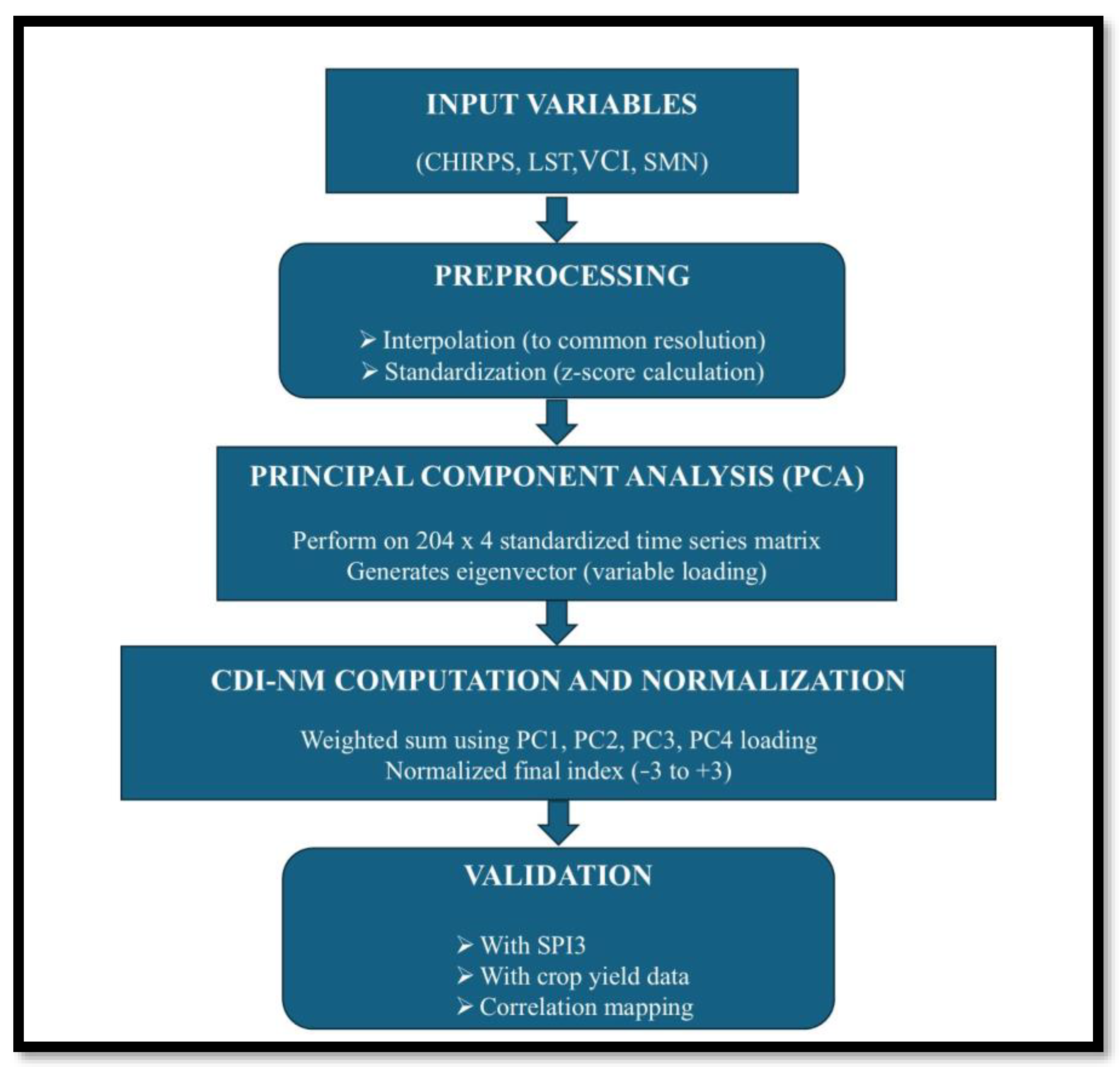
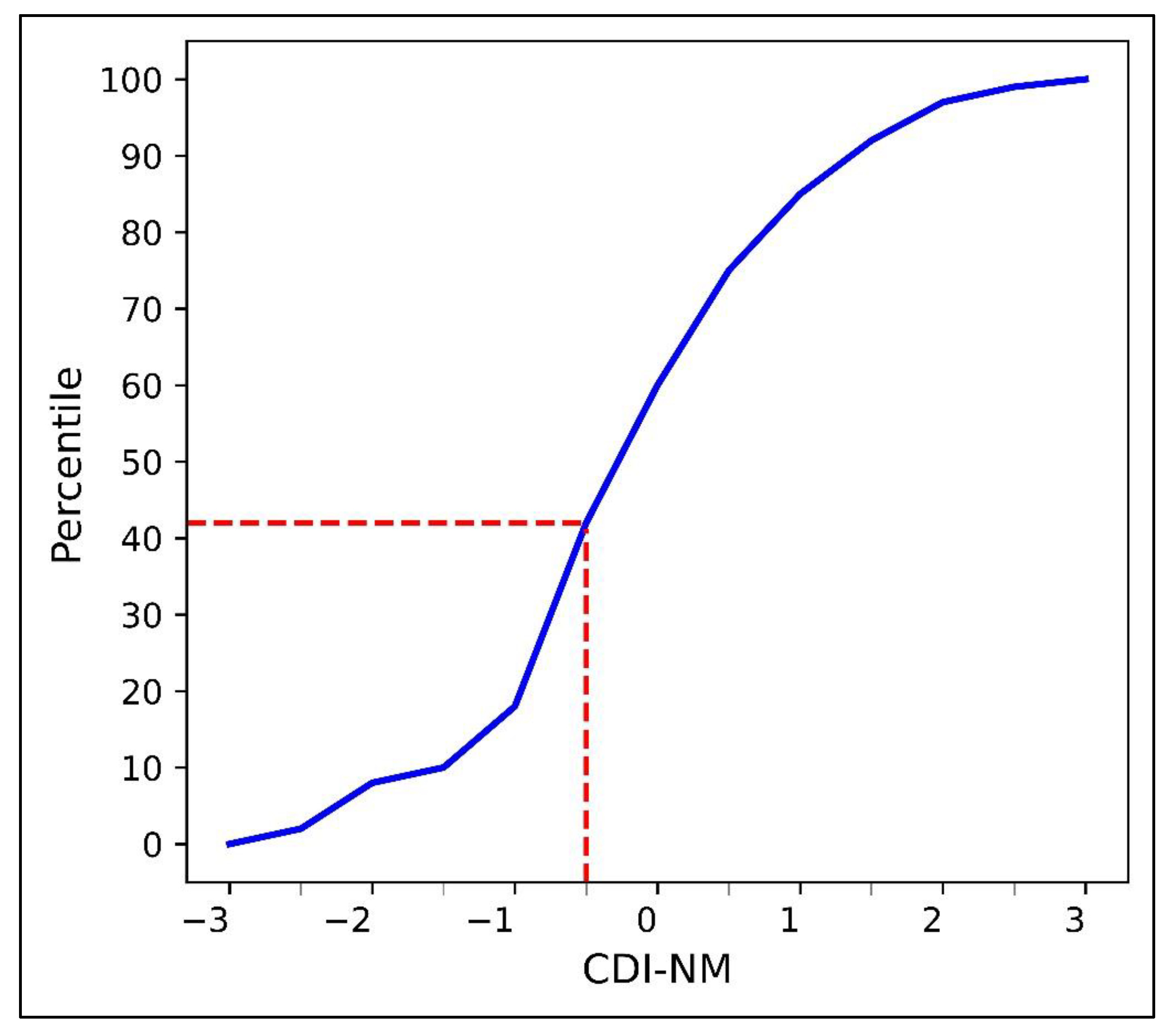
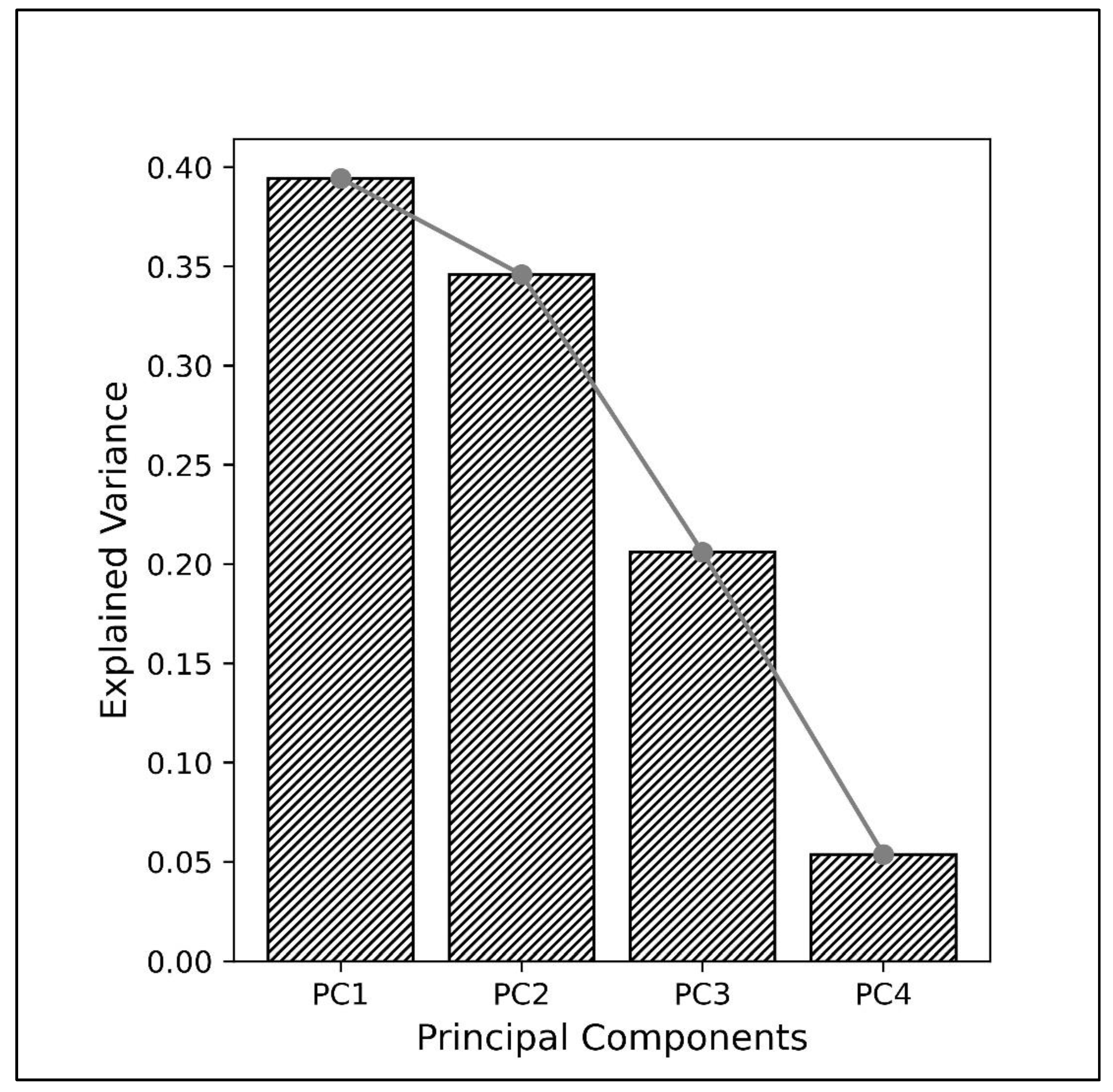
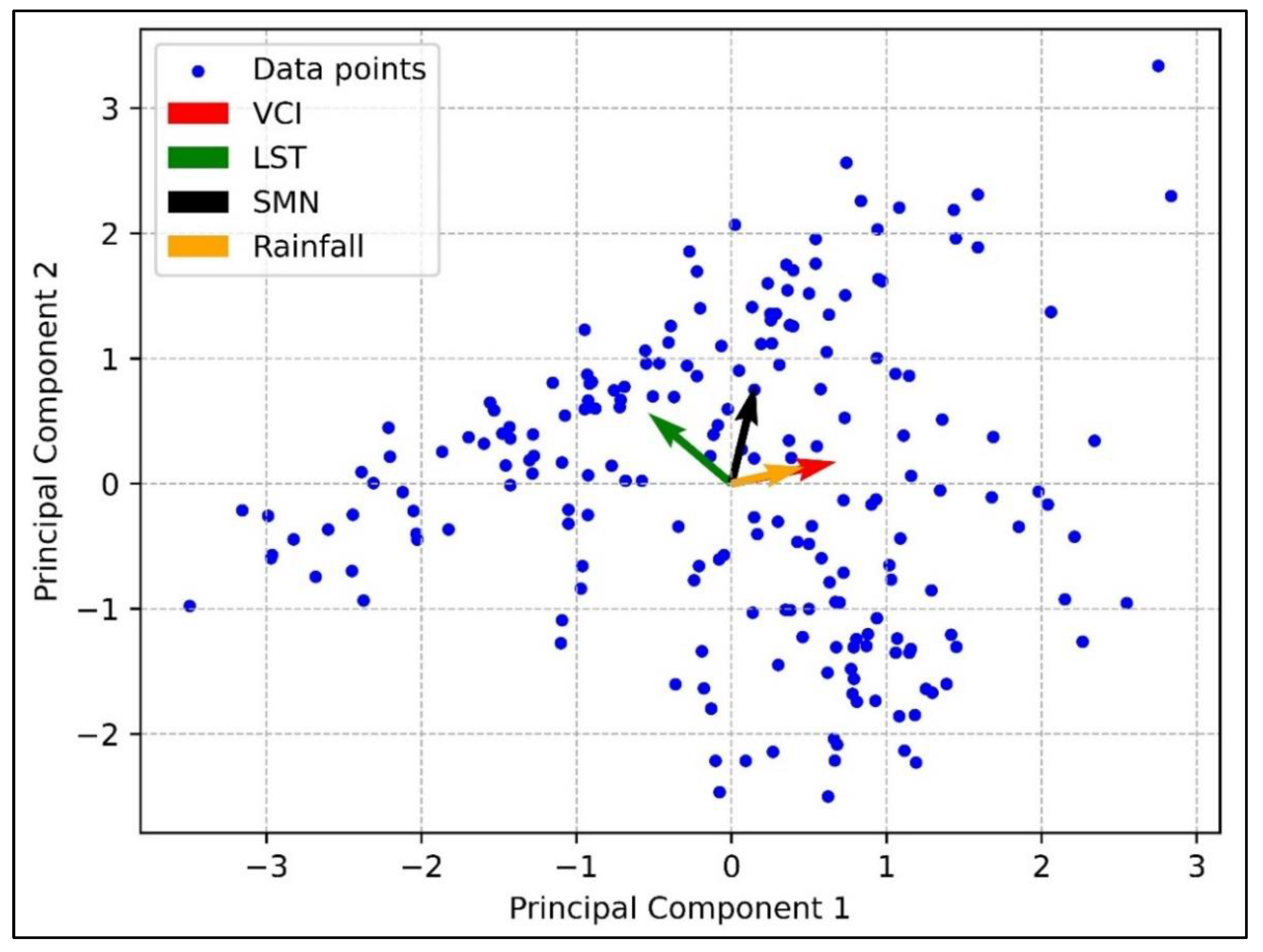
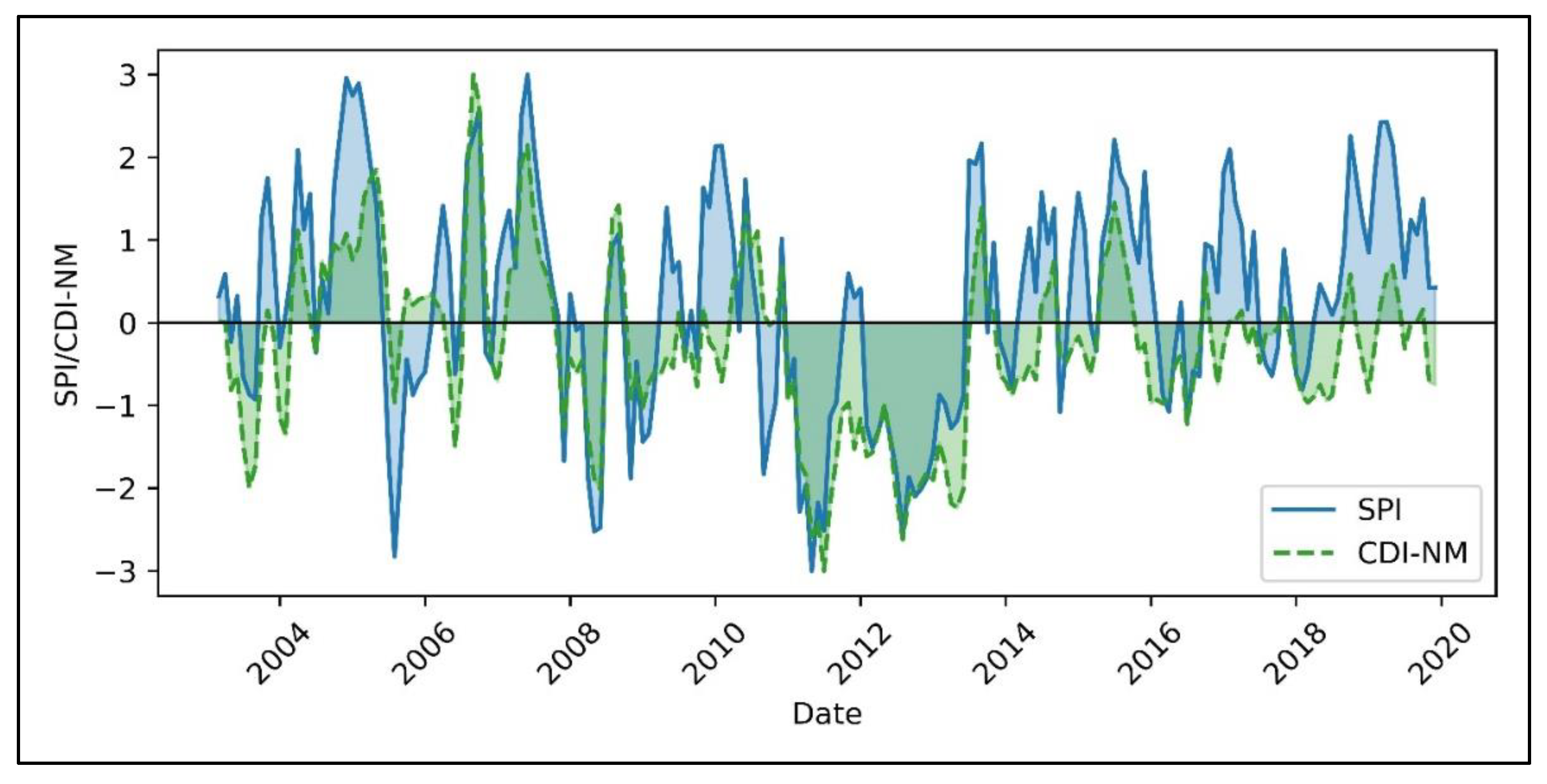
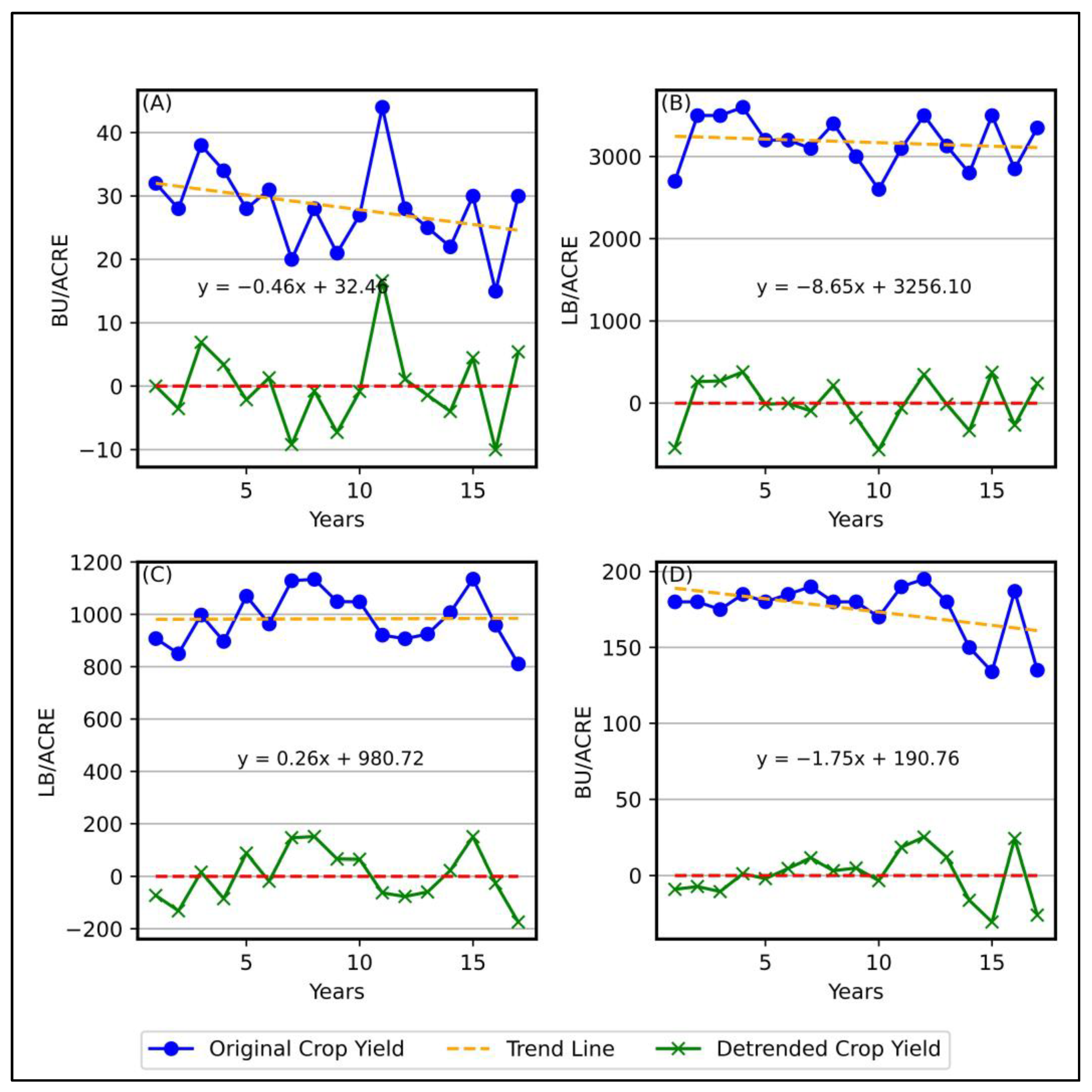

| Test | Value |
|---|---|
| Kaiser–Meyer–Olkin (KMO) | 0.786 |
| Bartlett’s Test of Sphericity | |
| Approx. Chi-squared | 26.5 |
| Degree of Freedom (DF) | 6 |
| Significance (Sig.) | 0.00013 |
| CDI-NM | Percentile | Drought Category |
|---|---|---|
| 0 to −0.99 | 61.39% | Mild drought |
| −1.00 to −1.49 | 18.81% | Moderate drought |
| −1.50 to −1.99 | 12.87% | Severe drought |
| ≤−2.00 | 5.94% | Extreme Drought |
| Covariance Matrix | VCI | LST | SMN | Rainfall |
|---|---|---|---|---|
| VCI | 1.00 | −0.43 | 0.35 | 0.78 |
| LST | −0.43 | 1.00 | −0.4 | −0.48 |
| SMN | 0.35 | −0.4 | 1.00 | 0.56 |
| Rainfall | 0.78 | −0.48 | 0.56 | 1.00 |
| Loadings | PC1 | PC2 | PC3 | PC4 |
|---|---|---|---|---|
| VCI | 0.68 | 0.18 | −0.44 | 0.56 |
| LST | −0.54 | 0.57 | 0.16 | 0.60 |
| SMN | 0.15 | 0.79 | −0.16 | −0.57 |
| Rainfall | 0.47 | 0.13 | 0.87 | 0.07 |
Disclaimer/Publisher’s Note: The statements, opinions and data contained in all publications are solely those of the individual author(s) and contributor(s) and not of MDPI and/or the editor(s). MDPI and/or the editor(s) disclaim responsibility for any injury to people or property resulting from any ideas, methods, instructions or products referred to in the content. |
© 2025 by the authors. Licensee MDPI, Basel, Switzerland. This article is an open access article distributed under the terms and conditions of the Creative Commons Attribution (CC BY) license (https://creativecommons.org/licenses/by/4.0/).
Share and Cite
Poudel, B.; Dahal, D.; Shrestha, S.; Sewa, R.; Kalra, A. Developing a Composite Drought Indicator Using PCA Integration of CHIRPS Rainfall, Temperature, and Vegetation Health Products for Agricultural Drought Monitoring in New Mexico. Atmosphere 2025, 16, 818. https://doi.org/10.3390/atmos16070818
Poudel B, Dahal D, Shrestha S, Sewa R, Kalra A. Developing a Composite Drought Indicator Using PCA Integration of CHIRPS Rainfall, Temperature, and Vegetation Health Products for Agricultural Drought Monitoring in New Mexico. Atmosphere. 2025; 16(7):818. https://doi.org/10.3390/atmos16070818
Chicago/Turabian StylePoudel, Bishal, Dewasis Dahal, Sujan Shrestha, Roshan Sewa, and Ajay Kalra. 2025. "Developing a Composite Drought Indicator Using PCA Integration of CHIRPS Rainfall, Temperature, and Vegetation Health Products for Agricultural Drought Monitoring in New Mexico" Atmosphere 16, no. 7: 818. https://doi.org/10.3390/atmos16070818
APA StylePoudel, B., Dahal, D., Shrestha, S., Sewa, R., & Kalra, A. (2025). Developing a Composite Drought Indicator Using PCA Integration of CHIRPS Rainfall, Temperature, and Vegetation Health Products for Agricultural Drought Monitoring in New Mexico. Atmosphere, 16(7), 818. https://doi.org/10.3390/atmos16070818










